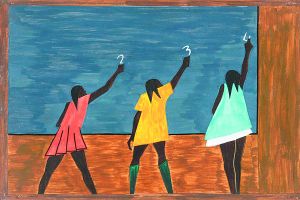(单词翻译:单击)
听力文本
This is Scientific American — 60-Second Science. I'm Erika Beras.
Got a minute?
It's called the Great Migration—the journey of some six million African-Americans from the rural south to northern and western cities between 1910 and 1970. The cultural impact of the Great Migration has been well documented. But researchers have also started to look at its genetic implications. The most recent study finds that the migration had a significant effect on genomic diversity across the nation. That work is in the journal PLOS Genetics.
To estimate patterns of ancestry, researchers analyzed genetic data from nearly four thousand African-Americans who had participated in three medical studies.
Their findings confirmed historical records—genetic evidence showed that female slaves often gave birth to children fathered by white slaveowners. The genetic analysis found that 82.1 percent of the average African-American's ancestors came from Africa, while 16.7 percent were Europeans and 1.2 percent were Native American.

The team also could date when particular genes entered the mix. Native American genes were introduced into the typical African-American genome in the early 1600's. Genes from Europeans were for the most part introduced in the decades before and during the Civil War.
Researchers also found those still living in the southern United States have a greater percentage of African ancestry than those in the north or west. And European-Americans who now live in the south are more genetically similar to African-Americans in the north and west than they are to African-Americans currently living in the South—because Blacks with a greater percentage of European ancestry were more likely to move, especially early in the migration's history.
The analysis has implications for medical research and treatment. Most of the people in studies linking genes and disease have been white, thus potentially leaving gaps in medical information specific to other races. Filling in those gaps, along with better access to medical care, could help reduce the disparity in health experienced by many minority communities.
Thanks for the minute for Scientific American — 60-Second Science Science. I'm Erika Beras.
参考译文
这里是科学美国人——60秒科学。我是艾丽卡·贝拉斯。
有一分钟时间吗?
所谓的大迁徙是指,在1910年到1970年间,大约六百万名非裔美国人从南部农村迁移到北部和西部城市的进程。大迁徙对人类文化的影响已经被广为记载。但是研究人员已经开始研究此次迁移活动所具有的遗传学意义。最新的研究结果表明,这次迁移对美国的基因多样性产生了巨大的影响。该研究结果发表在《公共科学图书馆遗传学》期刊上。
为了估计祖先的基因模式,研究人员们对曾参与过三项医学研究的约4000名非裔美国人的遗传信息数据进行了分析研究。
他们的研究结果证实了历史记载,遗传证据表明,女性奴隶经常孕育白人奴隶主的后代。遗传分析发现,平均有82.1% 的非裔美国人的祖先来自非洲,16.7% 的祖先是欧洲人,1.2%的是美国本土人。
研究团队也可以推定特定基因进入混合基因组的时间。17世纪初,美国本土基因进入了典型的非裔美国人的基因组。而欧洲人的基因大部分是在在美国内战前和内战期间引入的。
研究人员还发现,与居住在美国北部和西部的人相比,那些仍住在美国南部的人基因中的非洲血统成分更多。与目前生活在南部的非洲裔美国人相比,现在生活在南部的欧裔美国人与生活在北部和西部的非裔美国人的遗传基因更为相似,因为拥有更大比例欧洲血统的黑人更有可能转移生活地,在大迁移历史记录的早期阶段尤其如此。
这项遗传分析对医学研究和治疗具有重要意义。参与关联基因和疾病研究的多数是白人,这就使其他人种的医疗信息留下了空白。填补上这些空白并提供更好的医疗护理,将会有助于减少很多少数族裔地区的健康差异。
谢谢大家收听科学美国人——60秒科学。我是艾丽卡·贝拉斯。
译文为可可英语翻译,未经授权请勿转载!
重点讲解
重点讲解:
1. give birth to 生(孩子);分娩;生育;
例句:She'll give birth to her first baby this summer.
她今年夏天要生第一胎。
2. for the most part 大部分;多半;通常;
例句:His designs, for the most part, corresponded with the actual needs.
他的设计绝大多数情况下都符合实际需要。
3. be similar to 相像的;相仿的;类似的;
例句:This story is similar to the one Ray wrote.
这个故事与瑞所写的类似。
4. be likely to do sth. 可能(做…)的;有(…)倾向的;
例句:These old buildings are very likely to be knocked down in a year or two.
在一两年之内这些老房子很有可能被拆掉。


